Table of Contents
Executive Overview
Philippine football is at a turning point. Interest spikes during international windows and big tournaments, but sustained growth requires more clubs, better stadiums, credible owners, and a predictable calendar. This long-form guide lays out a practical blueprint for CPL expansion—from ownership due diligence and club licensing to city selection, finances, youth pathways, media deals, and timelines. Whether you’re an investor, mayor, athletic director, or supporters’ group, you’ll find checklists, scorecards, and policy templates that translate ambition into execution.

1) Why Football Expand the CPL Now?
1.1 Demand signals
- Demographics: A young, digitally native population that streams sports on mobile and engages with communities on TikTok, YouTube, and Facebook.
- Football awareness: Higher visibility through international tournaments, school programs, and diaspora influence.
- Untapped markets: Regional hubs with stadiums, universities, and corporate sponsors lack a professional football identity.
1.2 The expansion flywheel
- New clubs bring local rivalries → attendance and regional pride rise.
- Better venues attract families and brands → stronger revenues.
- Academies create homegrown heroes → national team depth improves.
- Credible governance unlocks institutional sponsors and city support.
2) Football Defining the CPL and Its Future-Proof Structure
This guide uses CPL as a shorthand for the men’s top-tier, club-based pro league in the Philippines. The core design principles:
- Independent league entity with a professional commissioner’s office.
- Club licensing tied to stadium, academy, legal, and financial criteria.
- Centralized media & commercial rights with transparent revenue sharing.
- Competitive balance tools (salary cost ratio, homegrown minutes).
- Women’s league alignment and youth pyramid integration.
3) Football Ownership: Models, Guardrails, and Due Diligence
3.1 Ownership models that work
A) Corporate-backed clubs
- Pros: capital, governance systems, sponsor networks.
- Risks: leadership turnover, strategic pivots.
- Mitigation: multi-year commitment letters, escrowed capex for stadium/academy.
B) Member-influenced or supporters’ trusts
- Pros: community legitimacy, stable matchday base.
- Risks: capital constraints.
- Mitigation: hybrid structure (anchor investor + trust with golden share on identity/relocation).
C) University/municipal partnerships
- Pros: facilities access, grassroots pipeline.
- Risks: bureaucracy, election cycles.
- Mitigation: MOUs with fixed tenancy, maintenance cost-sharing, ring-fenced sport budgets.
D) Multi-Club Ownership (MCO)
- Pros: data sharing, loan pathways, scouting efficiency.
- Risks: conflicts of interest, competitive integrity.
- Mitigation: strict MCO rules (no dual control in same competition phase, disclosure of related-party deals, transfer valuation audits).
3.2 Owner fit test (league-side)
- Financial capacity: audited net worth, liquidity checks, rolling 24-month cash plan.
- Background checks: AML/KYC, political exposure review, beneficial ownership transparency.
- Business plan: 5-year forecast for operations, academy, stadium, community.
- Governance: independent directors, whistleblower policy, conflict-of-interest registry.
- Fan commitments: ticket affordability policy, supporter liaison officer (SLO), community hours.
Pro tip: Publish a Club Ownership Handbook outlining these standards to reduce ambiguity and accelerate serious bids.
4) Football Club Licensing 2.0: From Paper to Performance
4.1 Minimum criteria (Year 1–2)
- Stadium: 5,000+ capacity (expandable), safe standing/accessible seating, basic broadcast lighting, VAR-ready wiring, clean zones for sponsors, family section.
- Training ground: One full-size pitch + gym + physio room; women’s and youth access.
- Academy: U15/U17/U19 squads; safeguarding policy; minimum B-licensed head of youth.
- Staffing: Head coach (A license), GK coach, performance analyst, S&C, team doctor.
- Legal & finance: audited accounts; salary deposit guarantee covering 3 months.
- Community: school clinics program; SLO named with quarterly dialogue meetings.
4.2 Advanced criteria (Year 3–5)
- Stadium: 8,000–12,000 capacity, hybrid pitch, LED boards, TV compound, sustainable operations (solar/greywater).
- Academy: U13–U21 ladder, women’s academy, partner schools, injury tracking database.
- Integrity: independent integrity officer, mandatory education (match-fixing, betting rules).
- Data: centralized event data capture; shared analytics pool for all clubs.
5) Football Expansion Mechanics: How Many, How Fast?
5.1 Number of clubs
- Short term: stabilize at 10–12 clubs (balanced home-away season + playoffs).
- Medium term: expand to 14–16 with divisional scheduling to manage travel.
- Long term: consider two tiers with promotion/relegation once finances and venues mature.
5.2 Expansion fees & capital calls
- Set expansion fee at a level that screens out unstable bids but doesn’t deter regional investors (tie a portion to performance bond for stadium/academy capex).
- Capital calls only for defined league-wide projects (VAR rollout, broadcast upgrades).
5.3 City scoring rubric (100 pts)
- Market size & GDP (20)
- Stadium readiness & transport (20)
- Grassroots participation & school density (15)
- Sponsor base & tourism (15)
- Ownership quality (15)
- Rivalry potential & media footprint (15)
5.4 Illustrative city dossiers (examples to study)
- Cebu Metro: established sports market, airport hub, strong corporate base.
- Davao City: regional capital with stadium opportunities; university pipeline.
- Iloilo/Bacolod corridor: deep football culture, short-haul derbies.
- Cagayan de Oro/Iligan: Northern Mindanao anchor, growing universities.
- Clark/Angeles: central location, tourism, existing sports estates.
- Baguio/La Trinidad: altitude training narrative, youth tourism (requires covered pitch solutions).
Each bid should attach a 10-year venue plan, academy roadmap, and community pledges.
6) Football Competition Format & Calendar
- Season window: Align with AFC club competition calendar for transfer windows and player loans.
- Format: Double round-robin + Final Four weekend to crown champion (TV-friendly).
- Cup competition: Knockout cup including lower-tier and university teams (giant-killing stories).
- Super Cup: Season opener (league champion vs. cup winner), neutral venue rotation.
- All-Star/Derby Nights: Showcase local rivalries, skills challenges, U18 curtain-raisers.
7) Football Roster Rules: Competitive Balance with Local Identity
- Foreign player rule: Consider AFC 5-player model (5 eligible in matchday squad) while protecting local minutes.
- Homegrown minutes quota: Target U23 homegrown minutes (e.g., 1,000+ minutes per season per club).
- Salary cost ratio: Keep total squad spend ≤ X% of club football revenue (excl. owner equity injections) to prevent arms races.
- Loan pathways: Encourage domestic loans for U21 and cross-border MCO loans with transparent terms.

8) Football Youth Development & Pathways
8.1 Catchment & community
- Every CPL club adopts 10–15 schools for weekly clinics; coach education for PE teachers.
- Talent ID festivals every quarter; database of players with growth metrics.
8.2 Academy standards
- Periodized training (growth spurt aware), injury prevention (FIFA 11+), nutrition education.
- Education link: academic tutors, scholarship programs, anti-dropout pledge.
- Transition to senior: U19 & U21 competitions aligned with first-team schedule.
8.3 Women’s football
- Require each club to field a women’s senior team within 1–2 seasons and invest in girls’ academies; mirror media visibility and sponsorship packages.
9) Football Stadiums & Matchday: Make Going to the Game a Habit
- Family first: shaded seating, clean restrooms, nursing rooms, kids’ zones.
- Transport: shuttle buses from malls/schools; bike parking; ride-hailing partnerships.
- Ticketing: dynamic pricing, student discounts, “kids free” promos, season cards with perks.
- Food & culture: local vendors, regional dishes, live music—turn games into weekend festivals.
- Safety: stewarding plans, clear signage, code of conduct (anti-racism, anti-violence).
- Green matchday: water refill stations, recycling, plastic reduction.
10) Football Media Rights, Content & Data
10.1 Rights strategy
- Domestic: hybrid of FTA highlights + paid streaming for full matches; sub-licensing to regional stations for away markets.
- International: diaspora packages with English commentary; clip rights for social.
- Data rights: centralize event and tracking data; sell to analytics and betting (with strict integrity and age-gating).
10.2 Content factory
- Shoulder programming: docu-series (academy life), mic’d-up training, tactics explainers, women’s features.
- Creator collabs: safe-harbor clip sharing with attribution; fan-cam areas.
- Grassroots OTT: stream U17/U19 matches weekly to engage families and scouts.
11) Finance: Revenue Stacks & Cost Control
11.1 Club revenues
- Matchday: tickets, hospitality, parking, F&B shares.
- Commercial: front-of-shirt, sleeve, training kit, grassroots partners, local SMEs.
- Media/central: league distributions, prize money, data rights.
- Academy: camps, clinics, player sales sell-on clauses.
- Non-matchday: stadium tours, concerts (with pitch protection), community events.
11.2 Controls & transparency
- Quarterly reporting to league; wage-to-revenue monitoring.
- Independent audits of related-party transactions (MCO contexts).
- Central clearinghouse for transfers to ensure remittance and tax compliance.
11.3 Risk management
- Integrity unit (betting education, suspicious match alerts).
- Insurance (D&O, event cancellation, player injury).
- Crisis comms templates for weather, security, or misconduct incidents.
12) Supporters at the Center
- SLO program: listening sessions each quarter; fan surveys published.
- Ticket fairness: caps on away allocations’ markups; youth pricing guarantees.
- Culture: tifos, safe-standing pilot zones, supporter-made merch stalls.
- Community hours: each player to log 20+ hours per season in local outreach.
13) ESG & Social Impact
- Education: scholarships with partner schools, reading corners at stadiums.
- Health: free clinics on matchdays (BP checks), grassroots football for girls.
- Environment: solar roofs, rainwater reuse, tree-planting derbies.
- Reporting: annual impact report with third-party assurance.
14) The 2025–2030 Roadmap (Illustrative)
2025
- Publish Ownership Handbook and Club Licensing 2.0.
- Open expansion window; shortlist 6–8 bids.
- Sign domestic streaming deal; launch central data platform.
2026
- Admit 2–4 new clubs; pilot Final Four weekend.
- Launch women’s alignment plan; youth U19 league streaming.
2027
- Stadium upgrades (lighting/LED/TV compound).
- Introduce homegrown minutes quota; integrity education league-wide.
2028
- Reach 12–14 clubs; regional rivalry weeks.
- ESG framework with solar/greywater incentives.
2029–2030
- Consider two tiers feasibility study; promotion/relegation pilot with parachute supports.
- Renew media rights with larger reach and data add-ons.
15) Checklists
For prospective owners
- Provide audited financials & AML/KYC docs
- 5-year capex: stadium/training/academy
- Governance chart & independent directors
- Community plan (schools, clinics, SLO)
- Women’s & youth development plan
For cities/universities
- Venue MOU with clear tenancy
- Transport & safety plan
- School/college football alignment
- Local sponsor coalition
- Environmental permits & upgrades
For the league
- Transparent expansion rubric
- Licensing audits & timelines
- Integrity unit & education
- Media/content calendar & brand toolkit
- Annual ESG & financial disclosures
16) Common Pitfalls & How to Avoid Them
- Boom-bust spending: enforce salary cost ratios; reward sustainable growth.
- Paper academies: audit training hours, coach licenses, match minutes.
- Owner churn: minimum holding periods; fit-and-proper reassessments on change of control.
- Stadium lag: modular seating & phased upgrades; neutral-site games during renovations.
- Fan alienation: communicate early, cap price increases, preserve club identity (colors, crest).
17) Call to Action
Investors: Download the ownership checklist above, assemble your governance and capex plan, and book a league pre-application briefing.
City leaders: Form a football working group (transport, tourism, education, safety) and map your 10-year sports venue plan.
Universities: Offer dual-career paths and pitch access; become talent hubs.
Supporters: Organize as a trust, appoint SLO reps, and co-design fan-first matchday experiences.
Brands: Back youth clinics and women’s football; secure founding partner status before expansion slots close.
The prize: a competitive, community-rooted CPL that fills stadiums, grows homegrown stars, and strengthens the national team.
Final Whistle
CPL expansion is more than adding pins on a map. It’s a nation-building project in miniature: credible owners, real academies, safe and lively stadiums, fair rules, and fans at the heart. Get those right, and the Philippines won’t just watch football’s rise—it will lead it.
The guide lays out a practical blueprint to scale Philippine football through a stronger CPL (top-tier men’s league) built on credible ownership, rigorous licensing, fan-first stadiums, and data-driven governance. Demand drivers include a young digital audience, rising football awareness, and untapped regional markets. The proposed flywheel: new clubs spark local rivalries, better venues attract families and brands, academies create homegrown heroes, and transparent governance unlocks sponsorships.
Ownership & Governance. Four models are assessed—corporate-backed, supporter-influenced hybrids, university/municipal partnerships, and multi-club ownership (MCO). Guardrails include AML/KYC checks, 24-month funding plans, independent directors, community commitments, and strict MCO conflict rules. A public Ownership Handbook is urged to standardize expectations.
PH Softball: Brilliant National Team Preps for Asian Championships
Club Licensing 2.0. Year 1–2 minima cover: 5,000+ capacity stadiums with broadcast basics, proper training sites, U15–U19 academies, licensed staff, audited accounts, and community programs. By Year 3–5: 8,000–12,000 capacity, hybrid pitches, LED boards, expanded academy ladders (including women’s), integrity education, and centralized event data.
Expansion Mechanics. Stabilize at 10–12 clubs, then grow to 14–16 and ultimately two tiers with promotion/relegation once venues and finances mature. A city scoring rubric (market size, stadium readiness, grassroots depth, sponsor base, ownership quality, rivalry/media footprint) prioritizes bids. Expansion fees are tied to performance bonds for capex.

Competition & Roster Rules. Align season with AFC windows; use a double round-robin plus Final Four; add a national cup, Super Cup, and youth curtain-raisers. Balance local identity and parity via an AFC-style foreign player limit, U23 homegrown minutes quotas, salary cost ratios, and transparent loan pathways.
Pathways & Women’s Game. Each club adopts schools for clinics and talent ID, runs growth-aware training with injury prevention, and provides dual-career academic support. A women’s team and girls’ academy alignment is required within 1–2 seasons.
Stadiums & Matchday. Family-friendly amenities, transport links, dynamic ticketing, local F&B, strong stewarding, and green operations turn games into weekend festivals and recurring habits.
Media, Data & Finance. Hybrid rights (FTA highlights + paid streaming) and diaspora packages grow reach; centralized data and integrity monitoring protect the product. Revenue stacks blend matchday, commercial, media distributions, academy programs, and non-match events, under quarterly reporting and related-party audits.
Supporters & ESG. SLO programs, fair pricing, culture zones, and community hours put fans at the center. ESG actions span education, health clinics, and sustainability reporting.
A 2025–2030 roadmap sequences ownership standards, club admissions, stadium upgrades, homegrown quotas, and potential two-tier play—framed by checklists, pitfall alerts, and a call for investors, cities, schools, supporters, and brands to co-build a credible, community-rooted league.
Frequently Asked Questions (FAQ)
1) How much capital does a new CPL club need to start?
Budgets vary by city and venue, but responsible owners plan multi-year funding for payroll, staff, stadium tenancy, academy, and travel. A prudent rule is to hold cash or committed lines for 24 months of operations plus earmarked capex (training ground, broadcast-ready upgrades). The league can require a salary deposit guarantee (e.g., three months) to protect players and staff.
2) Will the CPL adopt promotion and relegation?
Yes—when the pyramid is ready. The near-term priority is stable clubs, credible owners, and fit-for-purpose venues. A second tier can emerge as facilities and finances mature, with parachute mechanisms and licensing to safeguard integrity.
3) How will the league protect competitive balance?
Through a salary cost ratio, homegrown minutes quotas, roster limits, and transparent MCO rules. Centralized data, integrity monitoring, and audits of related-party transactions will deter unfair advantages and match-fixing risks.
4) What’s expected of academies under licensing?
Minimum squads at U15/U17/U19; licensed coaches; safeguarding and education policies; injury prevention and nutrition programs; and structured school partnerships. Clubs must show actual training hours, match minutes, and progression to the first team.
5) What benefits do cities/universities get from hosting a CPL club?
Year-round events that boost tourism, F&B, and local SMEs; community programs for youth; international exposure; and utilization of sports infrastructure. With proper planning, clubs become city brands that attract sponsors and elevate civic pride.
